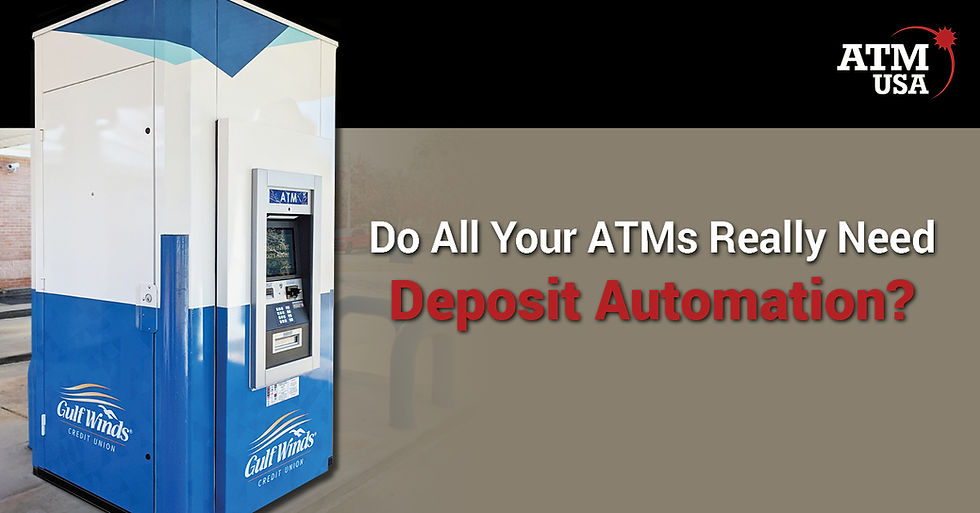What Do Credit Unions Really Need in a Digital Branch?
- alicia002
- Mar 29, 2024
- 3 min read
by Darren Smith | Originally published by CUInsight
In today's digital age, credit unions and their members are increasingly turning to self-service interactions driven by technology and artificial intelligence (AI). This has led to lower branch traffic, fewer on-site employees, and a focus on transitioning to digital branch operations. But what should a modern digital branch really include to meet members' evolving needs?

Advanced Transaction Capabilities
While standard transactions like cash and check deposits and withdrawals remain important, most members who visit a branch are looking for more “difficult” services such as investments, loans, account opening, and complex advice. Credit unions need to equip their digital branches with the ability to handle these advanced transactions.
There are multiple options for providing advanced services digitally. Interactive teller machines (ITMs) allow members to video conference with remote tellers to conduct a wide range of transactions. However, ITM solutions require significant capital investment and intense implementation efforts that may not be feasible for all credit unions. Plus, the member must still get in the car and drive to a remote location to use the machine.
Fortunately, new technologies such as Microsoft Teams, Google Business Tools, and MiniBranch are emerging that can provide ITM-level capabilities much more affordably. While all equipped with their own capabilities, these systems can combine functionality to meet needs such as easy-to-use backend platforms, mobile responsive user interfaces, video conferencing, and QR code technology. Leveraging this tech along with relatively inexpensive equipment like iPads, ATMs, and members’ personal mobile devices, credit unions can facilitate advanced digital branch interactions often rivaling ITMs.
Extended Service Hours
A key advantage of digital branches is the ability to offer extended service hours beyond standard branch operating times. By closing off back-office areas while keeping front vestibules and self-service zones open, credit unions can make basic transactions available nights and weekends with minimal staffing.
Consumer demand for extended banking hours is clear. Even major institutions like Commerce Bank have been rapidly expanding evening and weekend availability. It’s only logical for credit unions to consider the improvement to member convenience and stay competitive by leveraging digital capabilities to extend their service hours economically.
Digital Branches Anywhere
With the right technological approach, credit unions can take the digital branch concept even further by bringing services out of the traditional branch altogether. Today, it’s possible to convert mobile apps, QR codes, ATMs, and other self-service portals to a “digital branch anywhere” model.
This distributed digital branch model is an affordable, welcome alternative for credit unions struggling with low branch traffic or employment difficulties. Rather than operating underutilized full-service branches, they can strategically place unstaffed self-service points such as full-function ATMs and enable remote service delivery at a fraction of the cost.
To create a true digital branch anywhere, credit unions need backend systems that are flexible and powerful enough to facilitate banking services through diverse service endpoints and user interfaces. Combined with intuitive mobile apps, QR code interactions, and improved ATM capabilities, these backend platforms enable credit unions to provide more services wherever members need them most.
The Future is Digital
As consumer expectations evolve, credit unions must transform their branch operations to survive and thrive. A well-designed digital branch strategy is the key - allowing for secure self-service, extended hours, advanced capabilities, and service availability pretty much everywhere.
By investing in the right technologies – user-friendly mobile apps, QR codes, cost-effective self-service devices, and robust backend systems to power it all – credit unions can future-proof their member services. They can meet demands for convenience, accessibility, and digital-first banking experiences while controlling costs and optimizing staff efforts.
The digital branch revolution has arrived. With a thoughtful strategy and the proper supporting solutions in place, credit unions can embrace this paradigm shift to better serve their members and position themselves for long-term growth and success in our increasingly digital world.
Ready to Take the Next Step? Schedule a Demo.
Darren Smith, Vice President, ATM Management
darren@atmusa.com • 919-534-3232 • Schedule a Meeting
Craig Helmers, Vice President, ATM Management
craig@atmusa.com | 919-534-3233 | Schedule a Meeting









Commentaires